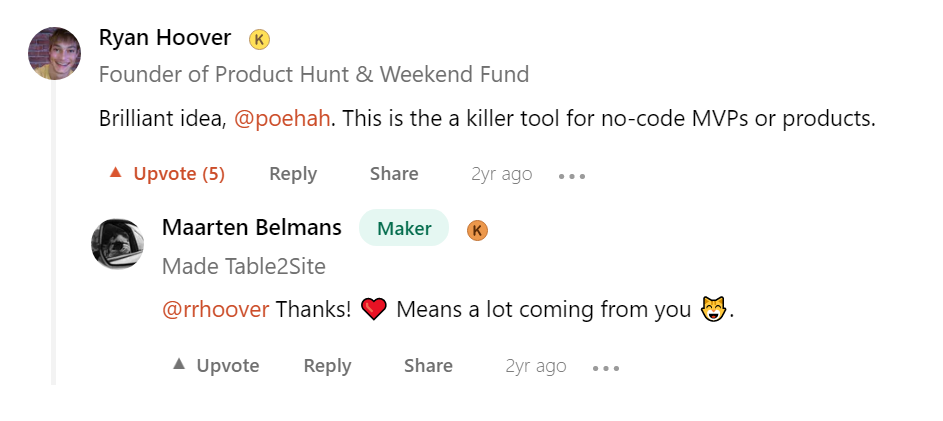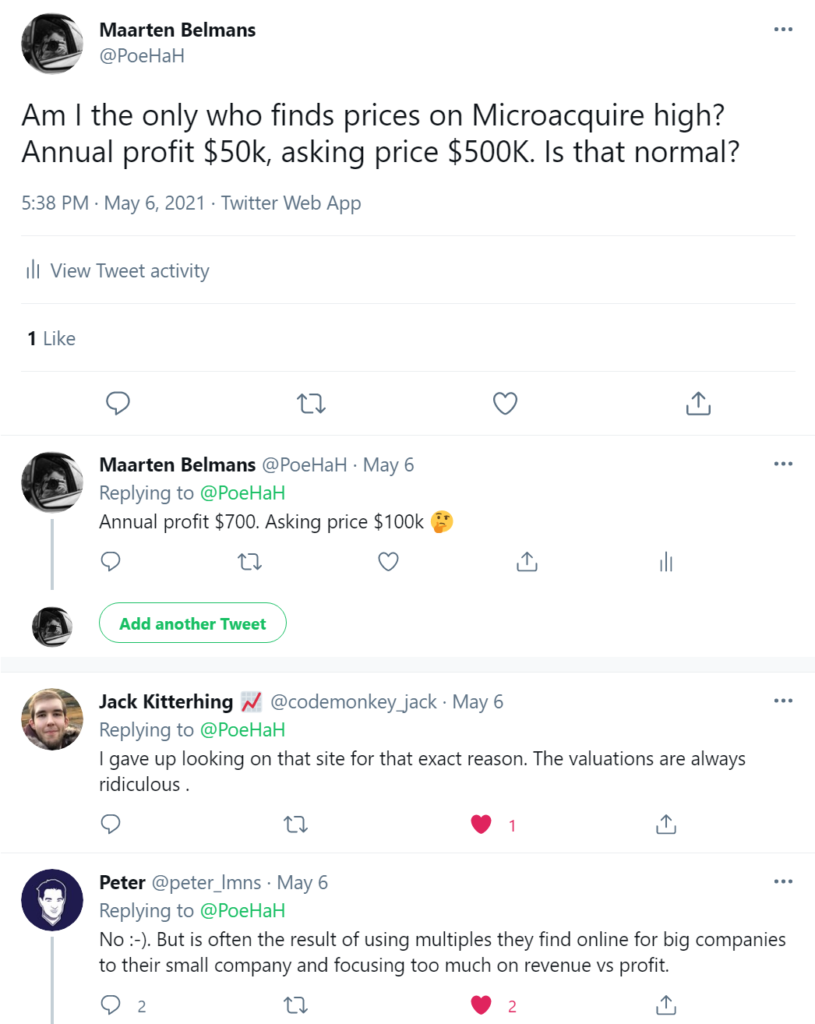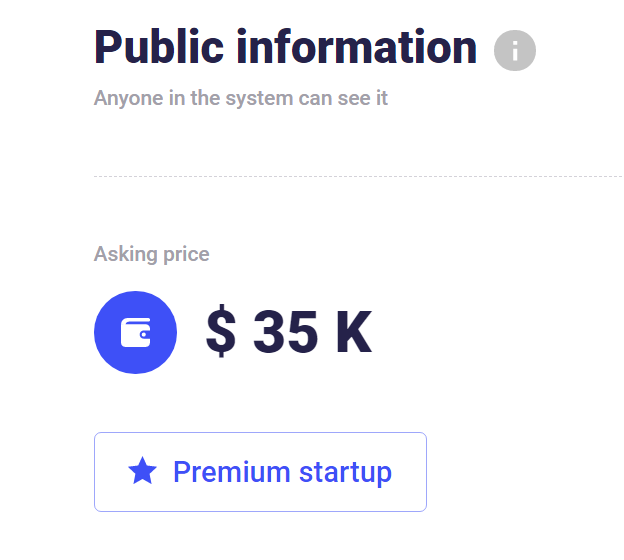I built a good, profitable SaaS product which required no marketing. And yet, I sold it on MicroAcquire. This is the story of why & how I sold Table2Site.
The launch
In March 2018, a cool no-code application launched that allowed you to build sites on top of Google Sheets. It was called Sheet2Site. The idea wasn’t new, but it came out right when “no-code” became a popular concept and the no-code community was growing rapidly.
The launch seemed successful, but some people were asking if Sheet2Site was also able to run on Airtable, a popular “Excel on steroids” platform that was also gaining momentum. Since the application was built to run exclusively on Google Sheets, it was clear there was an audience that still had an itch to scratch.
The launch of Sheet2Site made me realize there was an untapped niche market for a new no-code website builder. I started building Table2Site, which would allow users to build sites on top of Airtable. The name was inspired by Sheet2Site. In hindsight, that was a mistake as it could be confusing and made it look like I copied their product (first lesson learned!), which I didn’t. Thankfully, the amount of confusion was limited and users could see the many differences between both apps.
In October 2018, I launched Table2Site into the wild by posting it on ProductHunt. It made the front page, became the 5th product of the day, and got a comment from @rrhoover, so the launch was a success.

Growth
After its launch, Table2Site had a healthy linear growth path. MRR, total number of users, and total number of hosted sites kept increasing.

Many SaaS platforms seem to follow a different path: nearly no growth for the first months or years, and then a sudden exponential increase in MRR.
I felt lucky that Table2Site was different. It was profitable from the start, which made working on it so much more meaningful. What I was building was being used!
Moreover, I didn’t have to do any marketing (which I’m not great at anyway). I only did 3 things:
- Launch on ProductHunt.
- Write a launch post on IndieHackers.
- Share it once on the Airtable community forum.
I didn’t blog, didn’t do outreach, didn’t find partners, didn’t have an affiliate program, and didn’t have an SEO strategy. Instead, I was able to focus on what I like best: building a product. Somehow, Table2Site was growing without marketing. I was so lucky!
The turning point
Too much is too much
Even though Table2Site did well, it was never at the point where I could focus on it full time. I live in an expensive country with a high tax rate, so I would need a consistent monthly profit of around $10k to justify working on it full time.
I was growing another project and freelancing to pay the bills. I was juggling 3 income sources and working 7/7, for 14 hours per day.
No matter how young, energetic, or motivated you are, such a working schedule will eventually catch up on you. There was simply too much on my plate.
Limited skillset
Table2Site also requires some technical know-how about servers, SSL, domains, etc. Since it is hosting websites, the technical backend needs to be robust in order to scale. Quite frankly, that department is not my strong suit. I know how to code, but I’m not an expert at automating SSL creation or optimizing a Linux server. While the current setup for Table2Site is more than efficient, it was always in the back of my mind that – at some point – it would require an update.
I contemplated hiring someone to help out with those technical bits, and I briefly gave it a try. Ultimately, I didn’t have experience with hiring someone, I didn’t know what exactly I was looking for, and I already had too much going on. The energy wasn’t there to see this through to the end.
Should I stay or should I go now?
I started thinking about the future of Table2Site. It was clear I lacked the time & energy to grow Table2Site further, but its users deserved someone who actively developed the platform further.
The no-code space was a good space to be in (and still is!) considering its growing popularity. Table2Site was growing and had much more potential, so I was not ready to let it go yet. I’m an avid procrastinator, so I looked for a way to keep Table2Site active, while I searched for a solution.
Invite-only
In early 2020, I decided to turn Table2Site into an “invite-only” product. I figured this would:
- Decrease the number of support requests. There weren’t many to begin with, but when your plate is full, each new request feels like the final straw.
- Decrease the need for new features.
- Keep the user numbers low enough so no technical issues could arise.
- Give the product a feeling of exclusivity.
I’m not sure this was the right call, but it did help alleviate some of the stress I felt. It decreased growth, but users were still finding their way to Table2Site and asking for an invite (which I would often give). It gave me some time to think.
Time to sell
One year later, in Q1 2021, Table2Site was still invite-only. Furthermore, the roadmap hadn’t been updated with new features since May 2019.

It dawned on me that I was procrastinating the inevitable. I decided selling was the best way to give Table2Site users what they deserve.
I still see the same potential I saw when I created Table2Site, so this was not an easy or comfortable decision. But it definitely felt like the right decision.
The selling process
Once I had decided to sell Table2Site, I wanted it to go quickly. I still didn’t have much time or spare energy, so there was no point in dragging this along.
Listing on MicroAcquire
I had heard of broker platforms like Flippa or Empire Flippers, but never really liked those. I can’t put my finger on why that is. It’s not because Empire Flippers only seems to list high-earning businesses or Flippa has a lot of noise on its platform (which they definitely have). I think it’s more because the barrier to entry seems high. Buying a business is, well, serious business, but somehow it looks as if these platforms make it more difficult than it needs to be.
I had heard good things about MicroAcquire. It was built by @agazdecki and differentiates from how older platforms do things.
Some advantages
- MicroAcquire is younger than most established competitors, so it seems to have a better grasp on what buyers/sellers want today.
- It looks nice, clean, and simple.
- Even though it’s still a young company, they are growing rapidly and have a large enough user base.
- As a seller, you don’t pay a commission on the sale.
- They’re not really a broker, but rather a platform that brings buyers & sellers closer together. However, they do offer guides & tutorials on how to go about a successful sale.
- They are also creating a (Facebook) community for buyers.
- MicroAcquire as a whole feels more friendly than other platforms, and the barrier to buy/sell a product seems lower.
… and disadvantages
Just like with any platform, there are also some disadvantages:
- Most sellers don’t seem to price their product correctly. More than half of the listings appear to be priced too high. I’ve seen cases where the Annual Recurring Revenue (ARR) is ~$15k, but the asking price is ~$200k – that’s a multiple of 13 years! Now, I don’t know much about setting a correct price, and I know it depends on the kind of product you’re selling, but I would guess that most multiples are somewhere between 2 and 5 years.
When I was first looking into MicroAcquire, I thought this would demotivate potential buyers to use the platform. Some Twitter followers agreed:
- Their onboarding process needs some work. When you list your startup, you are asked to fill in a form on the website. After that, you’re redirected to fill in another form (via Typeform) with many of the same questions.
- There is no way to have a buyer and seller account at once. You need a separate account for buying and for selling.
- There is no way to set your product status as “sold”. Instead, your seller account is deactivated from the platform.
The advantages outweighed the disadvantages, so I decided to list Table2Site on this platform. And boy, am I happy I did!
The numbers
I listed Table2Site for $35K.

I can’t say exactly how much I sold it for (only the buyer can do that, in my opinion), but to my surprise, it was well above that!
I found pricing my SaaS correctly (as opposed to super high as some do) had the desired effect: my expectations could only be exceeded, and many buyers were interested.
The actual process
1. Validation
MicroAcquire has to approve your product first. It can take a few days before that process is completed. Once it is approved, it appears as a listing in the marketplace. It seems they use this process to edit the description of your product (to leave out sensitive information that is only visible privately) and create a pitch deck PDF file of your startup.
2. Buyer requests
Buyers can only see limited public information: asking price, ARR, competitors, and a short description (which was edited by MicroAcquire to leave out your startup name). At this point, they do not know who you are or what exactly you’re selling.
If a listing peeks a buyer’s interest, they can request more information. You have to approve or deny this request (manually or automatically). A potential buyer will only see your product’s name, link, and pitch deck PDF if you’ve approved it. This gives you control over who sees your listing.
Premium buyers are paying to see your listing before everyone else does. You can recognize them thanks to a badge next to their name. This further allows you to try and filter serious vs non-serious buyers.
Table2Site peeked the interest of quite a few buyers. I got about 16 requests. Some of those only sent a request so they could see the link to the product I was selling. About 10 of them were really interested and asked for more information.
3. Messaging
At this point, MicroAcquire is basically a messaging platform between you and potential buyers. They will ask questions about MRR, users, churn, … and negotiate on price.
Out of 10 people, 5 were bidding more than the asking price, and 3 of those were around the same price. In the end, I didn’t go for the highest offer, but the offer that would yield me the most profit after payment fees, VAT, etc.
After a few days of messaging back & forth, I decided on the final buyer, and we started hashing out a good way to do things. Here’s what we decided:
- 50% of the total price is paid up front.
- The seller (me) fixes a few bugs, prepares the code with additional comments, adds readme files with documentation, and then hands over the code.
- The seller creates some walk-through videos.
- The seller remains available for 30 days to answer questions.
- The seller hands over the payment gateway account.
- The remaining 50% is paid once all this is done.
- After receiving the remaining 50%, the domain name and server are handed over to the buyer.
I’m not sure this is a good agreement, but it sure feels that way to me. The buyer gets something without spending all their money, and the seller keeps something of value until the full amount is paid.
4. The finish line
As I write this, we’re in the final stage of the handover. The second 50% hit my account and I’m preparing to hand over the final pieces of the puzzle.
Part of me is sad that I couldn’t grow Table2Site into what I believe it can become. Nevertheless, I think I made the right decision by selling. I’m happy about a smooth and successful handover and will continue to follow Table2Site’s. I’m excited to see what its next steps are.

What’s next?
I have stopped freelancing for the time being, and my other side project is now my main focus. It feels liberating to focus exclusively on one business.
The “itch” to create something new still remains, so I’m open to a new (but more micro, please!) side project.
Thanks for reading! If you have any questions, you can reach out to me on Twitter 👋.

